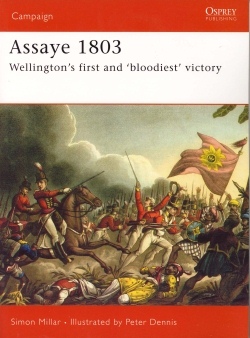 Campaign
166, Assaye 1803, Wellington’s first and ‘bloodiest’
victory, by Simon Millar, illustrated by Peter Dennis, ISBN 1-84603-001-3,
96 pages Campaign
166, Assaye 1803, Wellington’s first and ‘bloodiest’
victory, by Simon Millar, illustrated by Peter Dennis, ISBN 1-84603-001-3,
96 pages
Napoleon described Wellington as a “sepoy General” but ended
up by losing to him. Here is the story of Wellington’s first campaign
in India, culminating in the victory against the Mahrattas at Assaye.
All the political background is given of this time before the Raj, when
Britain was trying not to take over the country but to pacify it and stop
the raiding and internecine warfare. It is an interesting read in itself,
and for Sharpe fans it tells what really happened in the battle when Wellington
was unhorsed – where Bernard Cornwell has Sharpe winning his commission.
Recommended.
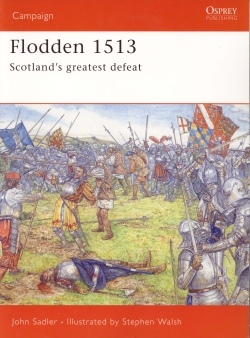 Campaign
168, Flodden 1513 Scotland’s greatest defeat, by John Sadler, illustrated
by Stephen Walsh, ISBN 1-84176-959-2, 96 pages Campaign
168, Flodden 1513 Scotland’s greatest defeat, by John Sadler, illustrated
by Stephen Walsh, ISBN 1-84176-959-2, 96 pages
This is the story of how James IV of Scotland sought to aid France by
pinning down England’s Northern armies when Henry VIII was engaged
in one of his wars with France. He was sent French instructors to tutor
his men in Swiss-style pike tactics, and had a strong position on top
of a hill that would have been hard to assail. The English forces marched
to his flank round the back of another hill and their sudden appearance
there forced him to realign his whole army in what was still a strong
defensive position. But he attacked the English, not realising that a
stream and marshy ground would disrupt the tight-packed formations needed
by pike tactics. The result was perhaps inevitable, opinions may differ
about what would have happened if some of his subordinates had played
a fuller role after an initial success against the English right wing.
This book gives a very complete picture of the political manoeuverings
before the campaign started and of the two armies’ composition as
well as of the actual campaign and the final battle. It is also full of
illustrations of both original and recreated armour and weapons, making
it an excellent reference for modellers who like the late medieval period.
Recommended!
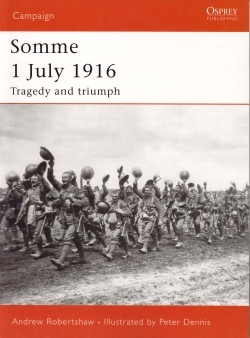 Campaign
169, Somme 1 July 1916, Tragedy and triumph, by Andrew Robertshaw, illustrated
by Peter Dennis, ISBN 1-84603-038-2, 96 pages Campaign
169, Somme 1 July 1916, Tragedy and triumph, by Andrew Robertshaw, illustrated
by Peter Dennis, ISBN 1-84603-038-2, 96 pages
This book deals with the first day of the 1916 Somme offensive by Britain
and France. This is often seen as an unmitigated failure, due to the massive
casualties and failure to make real progress, with orders given by Generals
far to the rear in comfortable chateaux, but perhaps this is not entirely
fair. At this time there was no way to pierce the German trenches except
by infantry assault with artillery aid, and some attempt had to be made
to avoid a complete stalemate with the German left in occupation of most
of Belgium and a large part of France. Tanks were still on the horizon,
and so were the massive artillery reinforcements that came later. Haig
is usually blamed for the lack of success, but perhaps the blame should
lie with his junior Rawlinson who failed to give clear instructions to
the infantry commanders at the front line. If the Great War is among your
interests read this book and decide for yourself where the blame lies.
Recommended
 Campaign
170, Osaka 1615, The last battle of the samurai, by Stephen Turnbull,
illustrated by Richard Hook, ISBN 1-84176-960-6, 96 pages Campaign
170, Osaka 1615, The last battle of the samurai, by Stephen Turnbull,
illustrated by Richard Hook, ISBN 1-84176-960-6, 96 pages
If the samurai interest you this is a book you shouldn’t miss.
It deals with Tokugawa Ieyasu crushing of his last enemies, the Toyotomi
clan whose stronghold was Osaka Castle. After describing the political
background and the opposing commanders and armies it covers first the
siege of Osaka Castle in the winter of 1614/15, with not just musketry
but cannon used by both sides. The siege ended with the Toyotomis submitting
and an armed truce, but a few months later campaigning began again with
a series of open-field battles that culminated in the fall of the Castle.
With copious illustrations from Japanese paintings backed up by modern
photographs of the battlefields plus excellent plates, maps and birds’-eye-views
this is an excellent book for modellers of the samurai to garner ideas,
quite apart from its great interest as a battle history.
Highly recommended.
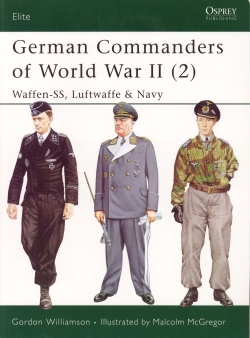 Elite
132, German Commanders of World War II (2) Waffen-SS, Luftwaffe &
Navy, by Gordon Williamson, illustrated by Malcolm McGregor, ISBN 1-84176-597-X,
64 pages Elite
132, German Commanders of World War II (2) Waffen-SS, Luftwaffe &
Navy, by Gordon Williamson, illustrated by Malcolm McGregor, ISBN 1-84176-597-X,
64 pages
This book gives interesting background to some of the people that WWII
modellers know only as commanders. The Waffen-SS generals are described
fairly, those responsible for atrocities being outnumbered by those who
were defended at Nuremberg by their enemies and shown not to be involved
in atrocities. Luftwaffe and Navy men get their fair share of this book,
in fact more than half of it. The plates are very good, and include some
interesting variations on campaign dress as well as the usual “full
dress” jackboot-and-breeches that we expect of senior German officers
so will be useful to figure modellers.
Recommended.
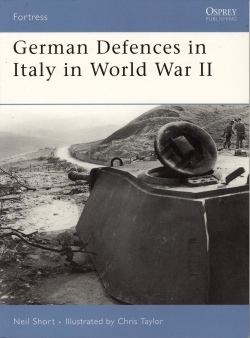 Fortress
45, German Defences in Italy in World War II, by Neil Short, illustrated
by Chris Taylor, ISBN 1-84176-938-X, 64 pages Fortress
45, German Defences in Italy in World War II, by Neil Short, illustrated
by Chris Taylor, ISBN 1-84176-938-X, 64 pages
This is good for anyone interested in the Italian campaign. It first
describes the geography of Italy, explaining why the various sites were
chosen for the German defence lines at key areas like Cassino and others
were sited as delaying positions. Their positions are shown on good maps.
Next aare descriptions of the fortifications themselves, most being field
fortifications not permanent concrete structures. Then there’s tour
of a typical site, showing how all its elements from mines to Pantherturms
worked together, and next is a description of how the Pantherturms and
the armoured MG Panzernests were installed. A further chapter deals with
combat in the Lines, and the last chapter tells what remains to be seen
today. There’s a good selection of photographs and plates and diagrams
to show the appearance of typical positions – one plate even shows
the installation sequence of an MG Panzernest. This is excellent reference
material for modellers.
Highly recommended.
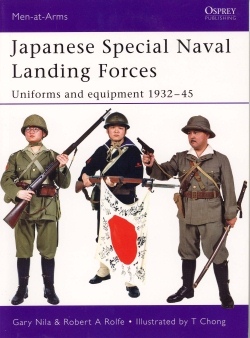 Men-at-Arms
432, Japanese Special Naval Landing Forces, Uniforms and equipment 1932-45,
by Gary Nila & Robert A Rolfe, illustrated by T Chong, Osprey Publishing
Ltd, ISBN 1-84603-100-1, 48 pages Men-at-Arms
432, Japanese Special Naval Landing Forces, Uniforms and equipment 1932-45,
by Gary Nila & Robert A Rolfe, illustrated by T Chong, Osprey Publishing
Ltd, ISBN 1-84603-100-1, 48 pages
The SNLF were not Marines as known in the west, with shipboard duties,
but soldiers for landing parties. As well as fighting as infantry they
also operated tanks, and in fact any tank with a Naval flag on it was
one of theirs. Here is all the information you need to model them, from
steel helmets to uniforms, rifles and heavier weapons (though not about
their tanks and armoured cars, that would have needed a longer book).
The text is clear and the illustrations include also colour photographs
of preserved uniforms, equipment and insignia, both worn by models and
displayed on mannequins, as well as very good plates.
Highly recommended.
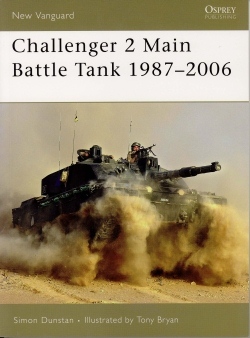 New
Vanguard 112, Challenger 2 Main Battle Tank 1987-2006, by Simon Dunstan,
illustrated by Tony Bryan, ISBN 1-84176-815-4, 48 pages New
Vanguard 112, Challenger 2 Main Battle Tank 1987-2006, by Simon Dunstan,
illustrated by Tony Bryan, ISBN 1-84176-815-4, 48 pages
This is a very good reference indeed for Challenger modellers. It starts
with the search for a replacement for Chieftain and describes all the
background to the decision to acquire Challenger 2 instead of any of its
foreign competitors. User trials are dealt with too, but most of the book
covers Challenger 2’s operations in Kosovo and the Gulf. There’s
a lot of fascinating reading here about combat in and near Basra. Many
photographs, in colour as well as black and white, show the tanks and
several of their variants though the only descriptions of the variants
are in the captions. The colour plates are arranged among the text pages,
not concentrated in its centre, and they include CRARRV in combat as well
as the battle tanks. A good selection of markings for Challenger 2 and
CRRARV is shown by the photos and plates, all with excellent captions.
Very highly recommended!
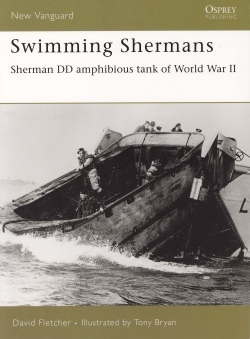 New
Vanguard 123, Swimming Shermans, Sherman DD amphibious tank of World War
II, by David Fletcher, illustrated by Tony Bryan, ISBN 1-84176-683-5,
48 pages New
Vanguard 123, Swimming Shermans, Sherman DD amphibious tank of World War
II, by David Fletcher, illustrated by Tony Bryan, ISBN 1-84176-683-5,
48 pages
This is a splendid book, not confined to the DD (Duplex Drive) Shermans
but dealing with all the swimming tanks. First there are notes on prewar
British ideas about how a tank could be made amphibious. Then Nicholas
Straussler’s ideas are discussed. He was provided with a Tetrarch
to test the concept of a waterproof screen with a propeller, and after
successful tests in 1941 the Valentine was selected for a production version
– though only two saw action, the rest being used for training.
The Sherman replacing them in the active service role, and the second
half of the book deals with its combat operations in WW2 and the few postwar
experiments with other tanks. Operations on D-Day are described in detail,
with a section on the improvements made following it. Then there are descriptions
of DD operations in the Scheldt Estuary, on the Mark Canal near Breda,
in the Rhine crossings, on the Elbe and in Italy. The good photographs
are supported by excellent plates. This is another excellent book from
David Fletcher, invaluable for modellers and tank enthusiasts.
Very highly recommended!
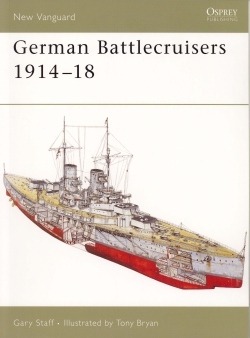 New
Vanguard 124, German Battlecruisers 1914-18, by Gary Staff, illustrated
by Tony Bryan, ISBN 1-84603-00-09, 48 pages New
Vanguard 124, German Battlecruisers 1914-18, by Gary Staff, illustrated
by Tony Bryan, ISBN 1-84603-00-09, 48 pages
The Germans only built seven battlecruisers, and all their stories are
here. The title refers to their war service but the tale here actually
begins with the first discussions in 1904 of such a vessel type and the
laying down of the first, von der Tann, in 1908. She was followed by successive
improvements – Moltke, Goeben, Seydlitz, Derfflinger, Lutzow and
Hindenburg – oddly enough all named for Generals, not sea officers.
Here is a very complete account of the differences between them and their
combat histories. Their designs were more battleworthy than those of British
battlecruisers, with heavier armour and better internal protection, so
only Lutzow was lost in action though several others suffered damage.
This is an excellent book for students of naval history – recommended.
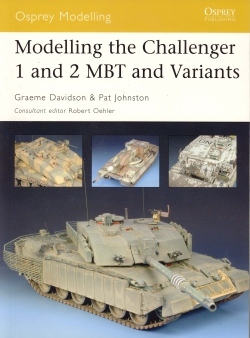 Osprey
Modelling 29, Modelling the Challenger 1 and 2 MBT and Variants, by Graeme
Davidson & Pat Johnston, ISBN 1-84176-927-4, 80 pages Osprey
Modelling 29, Modelling the Challenger 1 and 2 MBT and Variants, by Graeme
Davidson & Pat Johnston, ISBN 1-84176-927-4, 80 pages
This is a great book for Challenger modellers. It grades the builds
by star rankings up to five instead of the usual Intermediate, Advanced
and Master levels. The first is a three-star one, detailing Tamiya’s
1/35 Challenger1 Mk 3 as used by the King’s Royal Hussars in Kosovo
with several aftermarket sets and some simple scratchbuilt parts. Then
comes a one-star build of DML’s 1/72 Challenger 2, built as one
of the Royal Scots Dragoon Guards in Gulf War 2 with an Extratech etched
set and showing how to use epoxy putty to create a rolled tarp. Revell’s
Challenger I Mk 3 as used by 4th Armoured Brigade in Gulf War 1 is another
one-star 1/72 build with aftermarket etch and some resin and very simple
scratchbuilt items. The next model is three-star with Tamiya’s 1/35
Challenger 2 (Desertized) being converted to a Desert Challenger 2 of
the Royal Omani Army. This a fairly simple scratch conversion, just making
new hull side and rear plates and part of the engine deck. Then another
three-star 1/35 build converts Tamiya’s Challenger I into a CRARRV
with Accurate Armour’s conversion and some accessories. The degree
of difficulty for this one is concerned with weathering the white United
Nations colour scheme, not with the construction which is quite easy.
Then Tamiya’s Challenger 2 (Desertized) returns, this time at three-star
level as one fitted with bar armour with the Accurate Armour bar armour
set. Constructing this is described clearly to make it much easier for
anyone else to build. The final model is a four-star build with Tamiya’s
Challenger I, a Modelpoint gun barrel and a lot of scratchbuilding to
produce a Falcon 2 of the Jordanian Army. This is a major project with
a completely new turret and will be difficult for readers to copy because,
as the author says, there are few photographs of it and no plans are available.
He created the turret by extrapolating its dimensions from photographs,
but other modellers should be able to make the same calculations from
the photographs of his completed model. Every chapter gives suggestions
and techniques for painting and weathering, and there’s a good list
of kits and accessories.
Highly recommended.
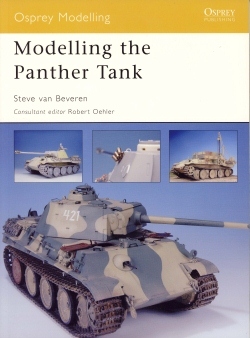 Osprey
Modelling 30, Modelling the Panther Tank, by Steve van Beveren, ISBN 1-84176-928-2,
80 pages Osprey
Modelling 30, Modelling the Panther Tank, by Steve van Beveren, ISBN 1-84176-928-2,
80 pages
This book details the building of five 1/35 scale models. First the
DML Panther Ausf A early, built as one used in Italy and at Intermediate
level build with several aftermarket resin and etched sets. Actual construction
is quite straightforward, and there’s a useful hints section on
the adding of a zimmerit finish. Next is a DML Ausf D modelled at Kursk
in 1943, at Advanced level because scratchbuilt resin castings are involved
and some etched parts are soldered together. The processes used are clearly
described and illustrated, so this is a good guide for anyone who hasn’t
tried either technique before.
Then there’s Tamiya’s Ausf G late type, built at Master level
as a tank from final production in March/April 1945 with a complete interior
from CMK’s interior sets, plus many other aftermarket and scratchbuilt
parts. Here there’s a useful section on how to make your own etched
metal parts, very handy! Finally the Special Feature describes modelling
a Bergepanther from DML’s early Ausf A and using its turret for
a complete Pantherturm ground mount. Building both models is clearly described,
and so is the construction of their scenic bases. The Bergepanther uses
the winch and other parts from the out-of-production On Track Models Bergepanther
Ausf G, but I suspect that it will be possible to correct and detail parts
from the Italeri Bergepanther if you can’t find the On Track kit.
Finally there’s a good section on the available 1/35 kits and accessories.
Recommended!
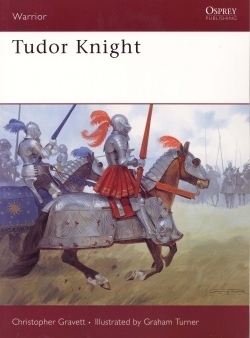 Warrior
104, Tudor Knight, by Christopher Gravett, illustrated by Graham Turner,
ISBN 1-84176-970-3, 60 pages Warrior
104, Tudor Knight, by Christopher Gravett, illustrated by Graham Turner,
ISBN 1-84176-970-3, 60 pages
This book covers the whole period from Henry VIII to Elizabeth I. Henry
originally had no English armourers, so imported some specialist from
Europe to set up an armoury at Greenwich. The armours made there changed
in style over the years, influenced by firearms and changes in fighting
styles and requirements. This book does not confine itself to the armours,
though, but deals with weapons and also gives a good picture of the raising
and organisation of an army in Tudor times as well as of life on campaign
in those days. A chapter covers the actual fighting experiences of English
armies against continental, Scots and Irish armies, and there are plenty
of photographs of surviving armour to back up the very good plates in
helping figure modellers.
Recommended.
|
|